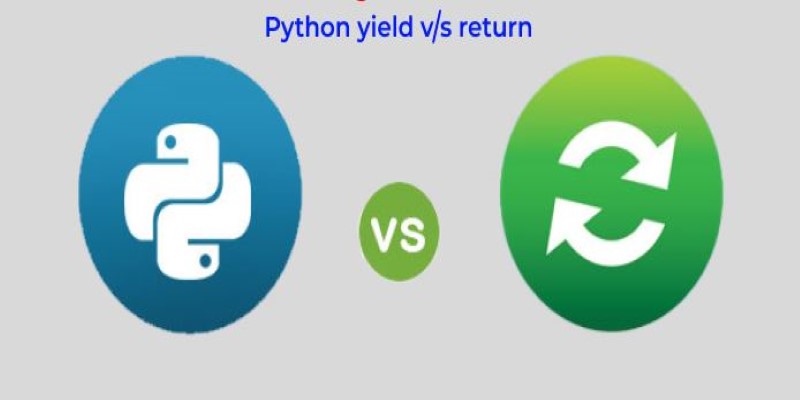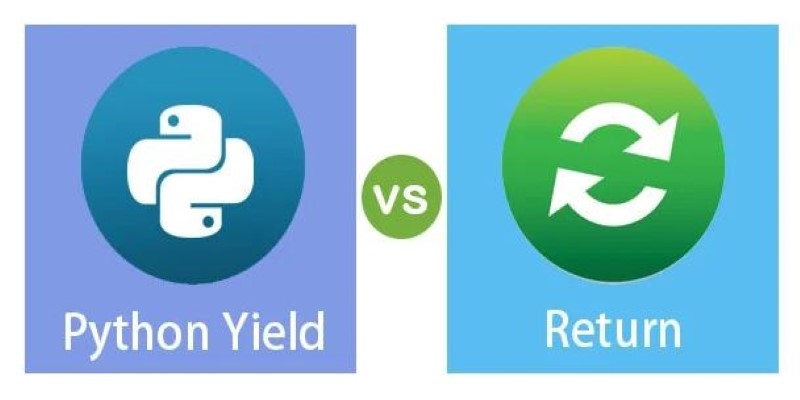Advertisement
Writing Python often feels intuitive, but there are areas where confusion creeps in—yield and return being a common example. Both send values back from a function, but their behavior is very different. Understanding how they work changes how you build functions, manage memory, and structure your logic. They may seem similar at first glance, but the way they interact with the rest of your program makes each useful in its way. Knowing when to use one over the other can lead to cleaner, more efficient code.
The return statement is the standard way to exit a function. It sends a value back to the caller and stops execution. Once Python hits return, the function ends immediately. Any code after that line won’t run.
Here’s a quick example:
def multiply(a, b):
return a * b
This function will multiply two numbers and exit after returning the result. That’s all it does. You get the value, and the function’s job is over.
Return is best when a function needs to perform a task and give one answer. It’s used in calculations, checks, or anything that doesn’t need to continue running once the result is ready. It’s simple and direct.
There’s no saved state with return. Each time you call the function, it runs from the beginning. It doesn’t remember anything from earlier calls. That works fine when you don’t need continuity.

Yield does something else. Instead of stopping the function, it pauses it. That pause allows you to resume the function later. When a function uses yield, it returns a generator object. That generator can then produce values one at a time, holding onto its internal state between uses.
This allows for functions that don’t finish immediately. You can step through them bit by bit.
Here’s a generator that counts up:
def count_up_to(n):
count = 1
while count <= n:
yield count
count += 1
Calling this function doesn’t return a list. Instead, it returns a generator you can loop over. Each value is generated as needed, and memory is utilized only for one item at a time.
This makes yield useful when working with large sequences. You don’t need to store everything in memory. The function continues from where it left off, which is efficient and useful for large tasks.
If your function needs to return a single result and terminate, use return. It's simple and fast. It works well when you want to perform a task, get the value you need, and move on.
However, if your function needs to return multiple results over time, yield is a better choice. It works especially well when you're reading from a file, processing a stream, or working with a large dataset. It lets you process each item as it comes in.
Here’s an example with file reading:
def read_file(path):
with open(path) as f:
for line in f:
yield line.strip()
This lets you read one line at a time, which saves memory. The file is read gradually, not all at once. If you used return to get all lines, you'd load the full file into memory. That can cause trouble with large files.
Generators are also helpful when you don’t know how many results you’ll need. You can stop when you’ve had enough and avoid doing unnecessary work. That’s a big plus for performance.
However, generators don't let you go backward. Once a value is used, it's gone. If you need to access previous results, you'll have to store them manually.
Another limitation is that generator functions using yield can’t be used where a normal return value is expected. You need to extract values with a loop or conversion, which adds a bit of work.

The key technical difference is memory handling. In return, the full result is calculated and sent back at once. The function's memory is cleared when it ends.
With yield, the function’s local variables stay alive. Each time you ask for the next value, the function resumes right where it paused. This saves memory and avoids recalculating work.
Take this Fibonacci example:
def fibonacci():
a, b = 0, 1
while True:
yield a
a, b = b, a + b
This generator keeps producing Fibonacci numbers forever. It holds the state of a and b between steps. Return can’t do this. You’d need to build and return a list, which takes memory and has a stopping point.
This state-saving feature makes yield useful for event-driven or stream-based work. It gives you precise control over how data is processed and when.
But this same flexibility makes debugging a bit harder. You can’t see all values at once without looping through the generator. If you’re not careful, it’s easy to forget the function is still running in the background.
Still, yield is ideal when working with long or infinite sequences or when you only need part of a dataset at a time. It can simplify code that would otherwise require complex loops or classes to manage state.
Yield vs Return: The choice between yield and return depends on what your function needs to do. The return gives a final answer and ends the function. Yield creates a generator that gives one result at a time, keeping the function alive between uses. Return is best when you want a single, finished value. Yield is better when you want a sequence, need to save memory, or keep state between steps. Both are useful tools in Python. They're not interchangeable, but they solve different problems. By understanding how they behave, you can decide which one fits the task at hand and write code that's clear, efficient, and easier to maintain.
Advertisement

How to kill processes in Linux using the kill command. Understand signal types, usage examples, and safe process management techniques on Linux systems

Microsoft’s new AI model Muse revolutionizes video game creation by generating gameplay and visuals, empowering developers like never before

Understand what are the differences between yield and return in Python. Learn how these two Python functions behave, when to use them, and how they impact performance and memory

Explore Claude 3.7 Sonnet by Anthropic, an AI model with smart reasoning, fast answers, and safe, helpful tools for daily use

How Introducing the Chatbot Guardrails Arena helps test and compare AI chatbot behavior across models with safety, tone, and policy checks in an open, community-driven environment

LeMaterial is an open source platform designed to accelerate materials discovery through shared tools, data, and machine learning workflows. Discover how it’s reshaping collaboration in materials research

Learn how to track real-time AI ROI, measure performance instantly, save costs, and make smarter business decisions every day

Know about 5 powerful AI tools that boost LinkedIn growth, enhance engagement, and help you build a strong professional presence

Master data preparation with Power Query in Power BI. Learn how to clean, transform, and combine datasets using simple steps that streamline your reporting process

Dell and Nvidia team up to deliver scalable enterprise generative AI solutions with powerful infrastructure and fast deployment

How to deploy and fine-tune DeepSeek models on AWS using EC2, S3, and Hugging Face tools. This guide walks you through the process of setting up, training, and scaling DeepSeek models efficiently in the cloud

Introducing ConTextual: a benchmark that tests how well multimodal models reason over both text and images in complex, real-world scenes like documents, infographics, posters, screenshots, and more